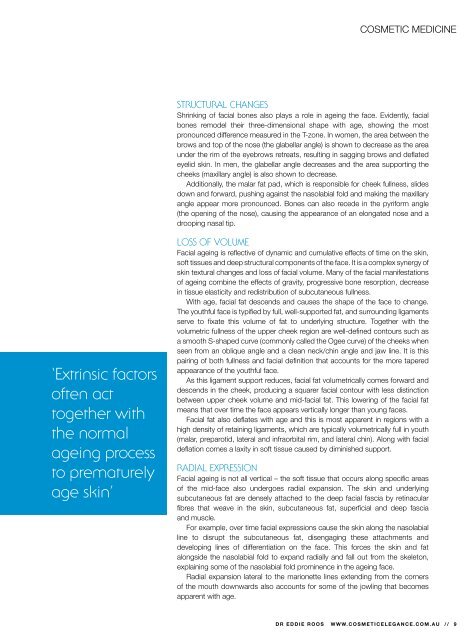Create successful ePaper yourself
Turn your PDF publications into a flip-book with our unique Google optimized e-Paper software.
COSMETIC MEDICINE<br />
STRUCTURAL CHANGES<br />
Shrinking of facial bones also plays a role in ageing the face. Evidently, facial<br />
bones remodel their three-dimensional shape with age, showing the most<br />
pronounced difference measured in the T-zone. In women, the area between the<br />
brows and top of the nose (the glabellar angle) is shown to decrease as the area<br />
under the rim of the eyebrows retreats, resulting in sagging brows and deflated<br />
eyelid skin. In men, the glabellar angle decreases and the area supporting the<br />
cheeks (maxillary angle) is also shown to decrease.<br />
Additionally, the malar fat pad, which is responsible for cheek fullness, slides<br />
down and forward, pushing against the nasolabial fold and making the maxillary<br />
angle appear more pronounced. Bones can also recede in the pyriform angle<br />
(the opening of the nose), causing the appearance of an elongated nose and a<br />
drooping nasal tip.<br />
‘Extrinsic factors<br />
often act<br />
together with<br />
the normal<br />
ageing process<br />
to prematurely<br />
age skin’<br />
LOSS OF VOLUME<br />
Facial ageing is reflective of dynamic and cumulative effects of time on the skin,<br />
soft tissues and deep structural components of the face. It is a complex synergy of<br />
skin textural changes and loss of facial volume. Many of the facial manifestations<br />
of ageing combine the effects of gravity, progressive bone resorption, decrease<br />
in tissue elasticity and redistribution of subcutaneous fullness.<br />
With age, facial fat descends and causes the shape of the face to change.<br />
The youthful face is typified <strong>by</strong> full, well-supported fat, and surrounding ligaments<br />
serve to fixate this volume of fat to underlying structure. Together with the<br />
volumetric fullness of the upper cheek region are well-defined contours such as<br />
a smooth S-shaped curve (commonly called the Ogee curve) of the cheeks when<br />
seen from an oblique angle and a clean neck/chin angle and jaw line. It is this<br />
pairing of both fullness and facial definition that accounts for the more tapered<br />
appearance of the youthful face.<br />
As this ligament support reduces, facial fat volumetrically comes forward and<br />
descends in the cheek, producing a squarer facial contour with less distinction<br />
between upper cheek volume and mid-facial fat. This lowering of the facial fat<br />
means that over time the face appears vertically longer than young faces.<br />
Facial fat also deflates with age and this is most apparent in regions with a<br />
high density of retaining ligaments, which are typically volumetrically full in youth<br />
(malar, preparotid, lateral and infraorbital rim, and lateral chin). Along with facial<br />
deflation comes a laxity in soft tissue caused <strong>by</strong> diminished support.<br />
RADIAL EXPRESSION<br />
Facial ageing is not all vertical – the soft tissue that occurs along specific areas<br />
of the mid-face also undergoes radial expansion. The skin and underlying<br />
subcutaneous fat are densely attached to the deep facial fascia <strong>by</strong> retinacular<br />
fibres that weave in the skin, subcutaneous fat, superficial and deep fascia<br />
and muscle.<br />
For example, over time facial expressions cause the skin along the nasolabial<br />
line to disrupt the subcutaneous fat, disengaging these attachments and<br />
developing lines of differentiation on the face. This forces the skin and fat<br />
alongside the nasolabial fold to expand radially and fall out from the skeleton,<br />
explaining some of the nasolabial fold prominence in the ageing face.<br />
Radial expansion lateral to the marionette lines extending from the corners<br />
of the mouth downwards also accounts for some of the jowling that becomes<br />
apparent with age.<br />
DR EDDIE ROOS WWW.COSMETICELEGANCE.COM.AU // 9


















